Thermal Behaviors and Interaction Mechanism of Ammonium Dinitramide with Nitrocellulose
Abstract
:1. Introduction
2. Results and Discussion
2.1. Thermal Behavior in Open Circumstances
2.2. Thermal Behavior in Close Circumstances
2.3. Thermal Behavior in Quasi-Adiabatic Circumstances
2.4. Thermal Behavior under Constant Temperature Conditions
2.5. Mass Spectroscopy Detection of Thermal Decomposition Gas Products
2.6. FTIR Spectroscopy Detection of Thermal Decomposition Gas Products
2.7. Interaction Mechanism of NC with ADN
3. Materials and Methods
3.1. Raw Materials
3.2. Thermal Behavior in Open Circumstances
3.3. Thermal Behavior in Closed Circumstances
3.4. Thermal Behaviors in Quasi-Adiabatic Circumstances
3.5. Thermal Behavior under Constant Temperature Conditions
3.5.1. Vacuum Tests
3.5.2. Air Atmosphere Tests
3.6. Gas Products Measurement
4. Conclusions
Author Contributions
Funding
Institutional Review Board Statement
Informed Consent Statement
Data Availability Statement
Conflicts of Interest
References
- Comtois, E.; Dubois, C.; Favis, B.D. Linear burning rate of double base propellant containing Azidodeoxycellulose. J. Energ. Mater. 2022, 40, 136–152. [Google Scholar] [CrossRef]
- Touidjine, S.; Boulkadid, K.M.; Trache, D.; Belkhiri, S.; Mezroua, A. Preparation and Characterization of Polyurethane/Nitrocellulose Blends as Binder for Composite Solid Propellants. Propellants Explos. Pyrotech. 2022, 47, e202000340. [Google Scholar] [CrossRef]
- Rodrigo, L.B.R.; Pedro, A.G.B.; Nami, L.N.; Fernando, C.P.; Maurício, F.L.; Tanos, C.C.F.; Letivan, G.M.F. Can green nitrocellulose-based propellants be made through the replacement of diphenylamine by the natural product curcumin? J. Energ. Mater. 2022, 40, 218–241. [Google Scholar] [CrossRef]
- Courty, L.; Gillard, P.; Ehrhardt, J.; Baschung, B. Experimental determination of ignition and combustion characteristics of insensitive gun propellants based on RDX and nitrocellulose. Combust. Flame 2021, 229, 111402. [Google Scholar] [CrossRef]
- Okada, K.; Saito, Y.; Akiyoshi, M.; Endo, T.; Matsunaga, T. Preparation and Characterization of Nitrocellulose Nanofiber. Propellants Explos. Pyrotech. 2021, 46, 962–968. [Google Scholar] [CrossRef]
- Zhang, X.; Weeks, B.L. Preparation of sub-micron nitrocellulose particles for improved combustion behavior. J. Hazard. Mater. 2014, 268, 224–228. [Google Scholar] [CrossRef]
- Dobrynin, O.S.; Zharkov, M.N.; Kuchurov, I.V.; Fomenkov, I.V.; Zlotin, S.G.; Monogarov, K.A.; Meerov, D.B.; Pivkina, A.N.; Muravyev, N.V. Supercritical Antisolvent Processing of Nitrocellulose: Downscaling to Nanosize, Reducing Friction Sensitivity and Introducing Burning Rate Catalyst. Nanomaterials 2019, 9, 1386. [Google Scholar] [CrossRef] [Green Version]
- Chen, F.-Y.; Xuan, C.-L.; Lu, Q.-Q.; Xiao, L.; Yang, J.-Q.; Hu, Y.-B.; Zhang, G.-P.; Wang, Y.-L.; Zhao, F.-Q.; Hao, G.-Z.; et al. A review on the high energy oxidizer ammonium dinitramide: Its synthesis, thermal decomposition, hygroscopicity, and application in energetic materials. Def. Technol. 2022, 19, 163–195. [Google Scholar] [CrossRef]
- Pang, W.Q.; Xu, H.X.; Li, Y.; Shi, X.B. Characteristics of NEPE propellant with ammonium dinitramide (ADN). Adv. Mater. Res. 2011, 399–401, 279–283. [Google Scholar] [CrossRef]
- Pang, W.; Fan, X.; Yi, J.; Zhao, F.; Xu, H.; Li, J.; Wang, B.; Li, Y. Thermal Behavior and Non-isothermal Decomposition Reaction Kinetics of NEPE Propellant with Ammonium Dinitramide. Chin. J. Chem. 2010, 28, 687–692. (In Chinese) [Google Scholar] [CrossRef]
- Wang, Q.; Xu, L.-P.; Deng, C.-Q.; Yao, E.-G.; Chang, H.; Pang, W.-Q. Characterization of Electrospinning Prepared Nitrocellulose (NC)-Ammonium Dinitramide (ADN)-Based Composite Fibers. Nanomaterials 2023, 13, 717. [Google Scholar] [CrossRef] [PubMed]
- Zhang, L.Y.; Heng, S.Y.; Liu, Z.R.; Zhang, G.; Zhao, F.Q.; Tan, H.M. Interaction of NC/NG with ADN. Chin. J. Energ. Mater. 2009, 17, 95–98. (In Chinese) [Google Scholar]
- He, S.R.; Zhang, L.J.; Heng, S.R.; Liu, Z.R. Study on interaction of ADN and (NC+NG) by gasometric method. Chin. J. Energetic Mater. 2008, 16, 225–228. (In Chinese) [Google Scholar]
- Li, J.Z.; Wang, W.; Liu, F.L.; Fu, X.L.; Fan, X.Z.; Zhang, L.Y.; Wang, Q. Influences of stabilizers on the nascent interaction between ADN and NC. Chin. J. Explos. Propellants 2011, 34, 61–65. (In Chinese) [Google Scholar]
- Yue, P.; Heng, S.Y.; Han, F.; Zhang, L.Y.; He, S.R. Compatibility of ADN with five kinds of binders. Chin. J. Energetic Mater. 2008, 16, 66–69. (In Chinese) [Google Scholar]
- Dauerman, L.; Tajima, Y.A. Thermal decomposition and combustion of nitrocellulose. AIAA J. 1968, 6, 1468–1473. [Google Scholar] [CrossRef]
- Makashir, P.S.; Mahajan, R.R.; Agrawal, J.P. Studies on kinetics and mechanism of initial thermal decomposition of nitrocellulose Isothermal and non-isothermal techniques. J. Therm. Anal. Calorim. 1995, 45, 501–509. [Google Scholar] [CrossRef]
- Wang, Y.; Liu, R.; Ning, B.K.; Pan, Q.; Hu, R.Z. A study of the thermal decomposition mechanism of of nitrocellulose. Chin. J. Energ. Mater. 1998, 6, 157–168. (In Chinese) [Google Scholar]
- Chai, H.; Duan, Q.; Cao, H.; Li, M.; Sun, J. Effects of nitrogen content on pyrolysis behavior of nitrocellulose. Fuel 2020, 264, 116853. [Google Scholar] [CrossRef]
- Brill, T.B.; Gongwer, P.E. Thermal Decomposition of Energetic Materials 69. Analysis of the kinetics of nitrocellulose at 50 °C–500 °C. Propellants Explos. Pyrotech. 1997, 22, 38–44. [Google Scholar] [CrossRef]
- Anatolii, I.K.; Yurii, I.R.; Georgii, B.M. Kinetics and Mechanism of Thermal Decomposition of Dinitramide. Propell Explos. Pyrot. 1999, 24, 37–42. [Google Scholar] [CrossRef]
- Ermolin, N.E.; Fomin, V.M. On the mechanism of thermal decomposition of ammonium dinitramide (review). Combust. Explos. Shock. Waves 2016, 52, 566–586. [Google Scholar] [CrossRef]
- Yang, R.; Thakre, P.; Yang, V. Thermal Decomposition and Combustion of Ammonium Dinitramide (Review). Combust. Explos. Shock. Waves 2005, 41, 657–679. [Google Scholar] [CrossRef]
- Kumar, P. An overview on properties, thermal decomposition, and combustion behavior of ADN and ADN based solid propellants. Def. Technol. 2018, 14, 661–673. [Google Scholar] [CrossRef]
- Wang, K.; Xue, B.; Chen, J.-G.; He, Z.-H.; Ji, Y.; Wang, B.; Lu, J.; Liu, Z.-W.; Liu, Z.-T. A combined experimental and theoretical study of the thermal decomposition mechanism and kinetics of ammonium dinitramide (ADN). New J. Chem. 2020, 44, 6833–6844. [Google Scholar] [CrossRef]
- Oxley, J.C.; Smith, J.L.; Zheng, W.; Rogers, E.; Coburn, M.D. Thermal Decomposition Studies on Ammonium Dinitramide (ADN) and 15N and 2H Isotopomers. J. Phys. Chem. A 1997, 101, 5646–5652. [Google Scholar] [CrossRef]
- Izato, Y.-I.; Koshi, M.; Miyake, A.; Habu, H. Kinetics analysis of thermal decomposition of ammonium dinitramide (ADN). J. Therm. Anal. Calorim. 2017, 127, 255–264. [Google Scholar] [CrossRef]
- Babrauskas, V.; Leggett, D. Thermal decomposition of ammonium nitrate. Fire Mater. 2020, 44, 250–268. [Google Scholar] [CrossRef]
- Izato, Y.-I.; Miyake, A. Thermal decomposition of molten ammonium nitrate (AN). J. Therm. Anal. Calorim. 2015, 122, 595–600. [Google Scholar] [CrossRef]
- Pavlov, A.N.; Grebennikov, V.N.; Nazina, L.D.; Nazin, G.M.; Manelis, G.B. Thermal decomposition of ammonium dinitramide and mechanism of anomalous decay of dinitramide salts. Russ. Chem. Bull. 1999, 48, 50–54. [Google Scholar] [CrossRef]
- Hu, R.Z.; Gao, S.L.; Zhao, F.Q.; Shi, Q.Z.; Zhang, T.L.; Zhang, J.J. (Eds.) Thermal Analysis Dynamics; Science Press: Beijing, China, 2008; pp. 79–80. [Google Scholar]
- Jin, M.; Luo, N.; Li, G.; Luo, Y. The thermal decomposition mechanism of nitrocellulose aerogel. J. Therm. Anal. Calorim. 2015, 121, 901–908. [Google Scholar] [CrossRef]
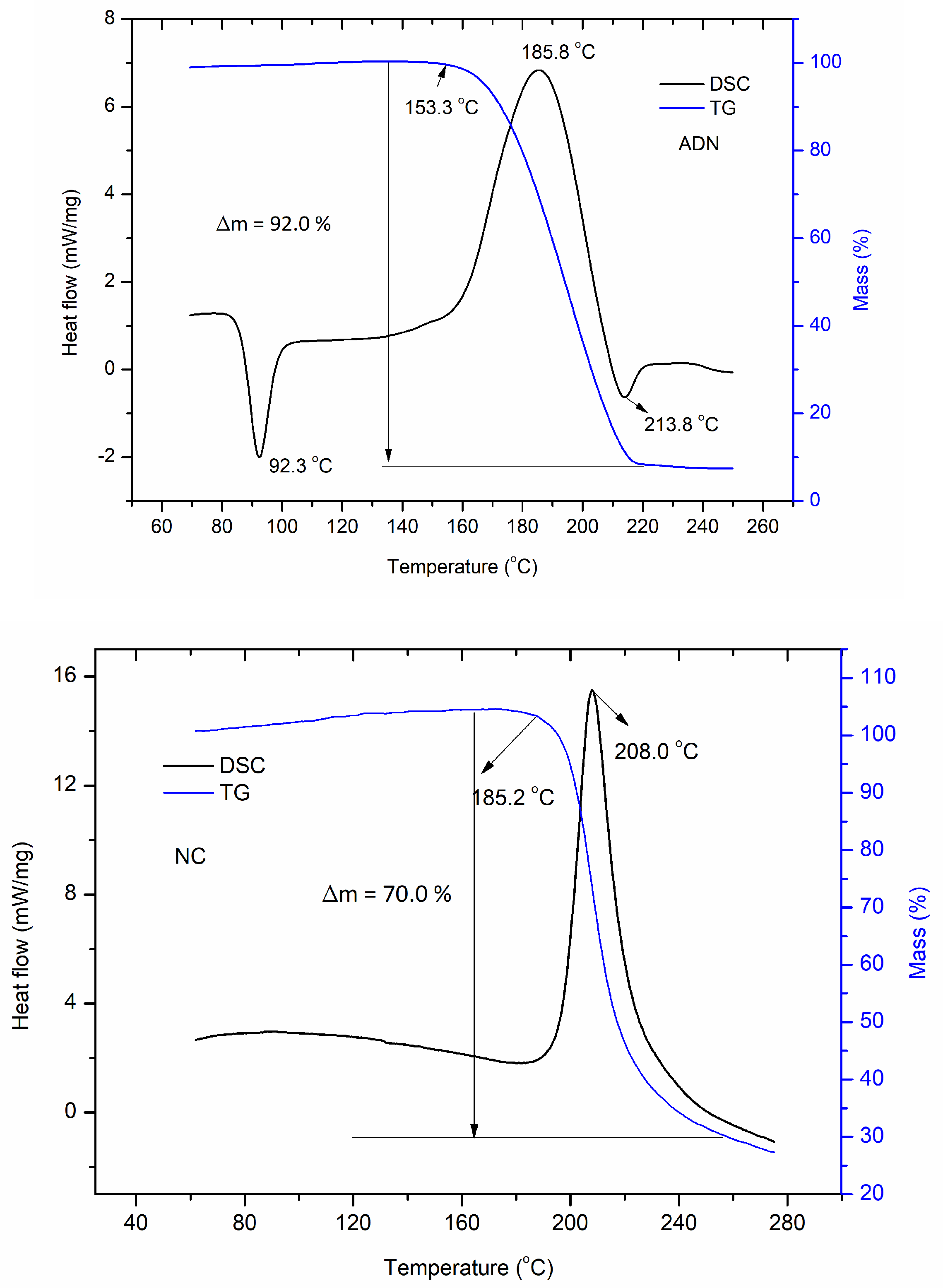

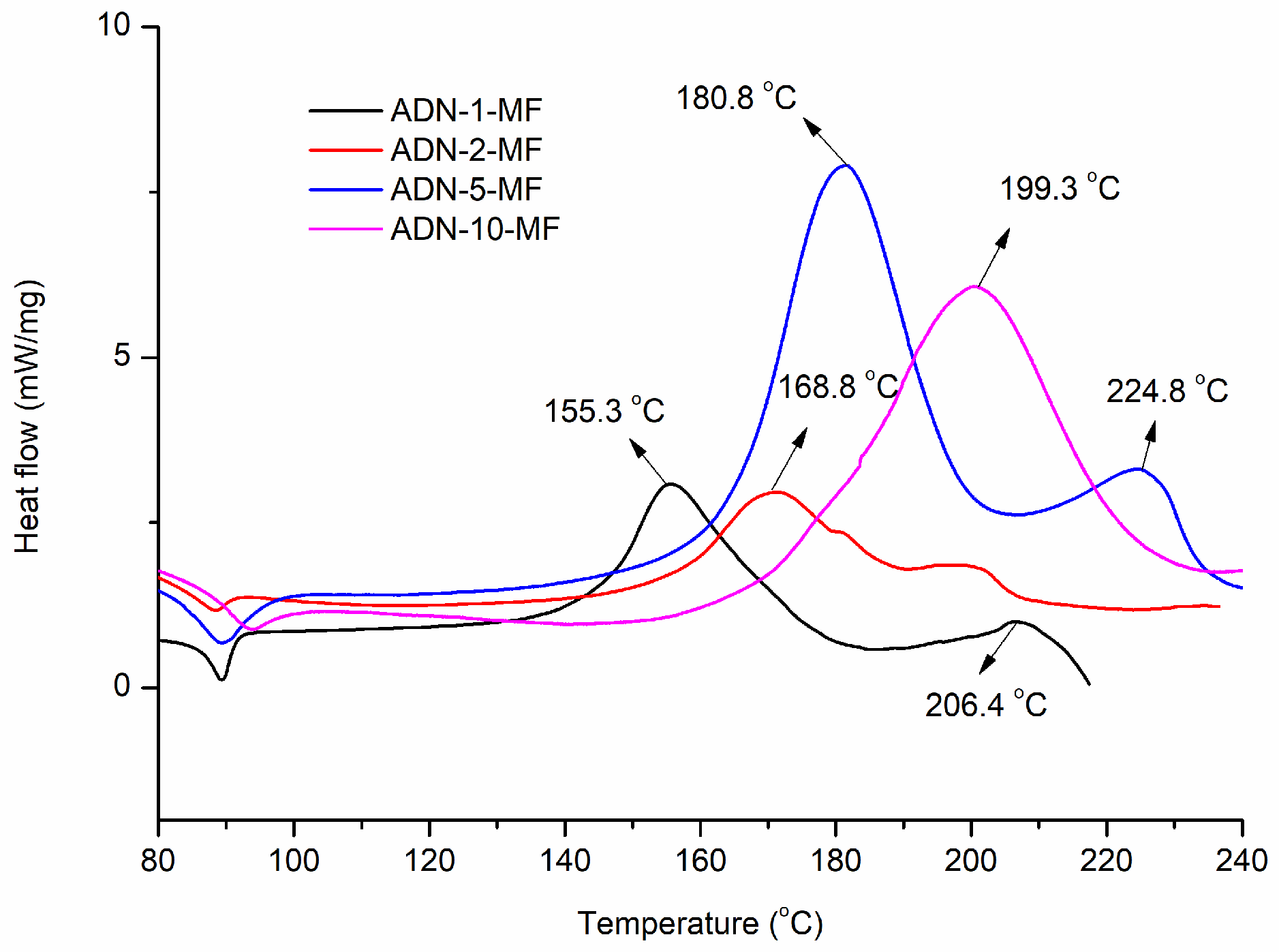
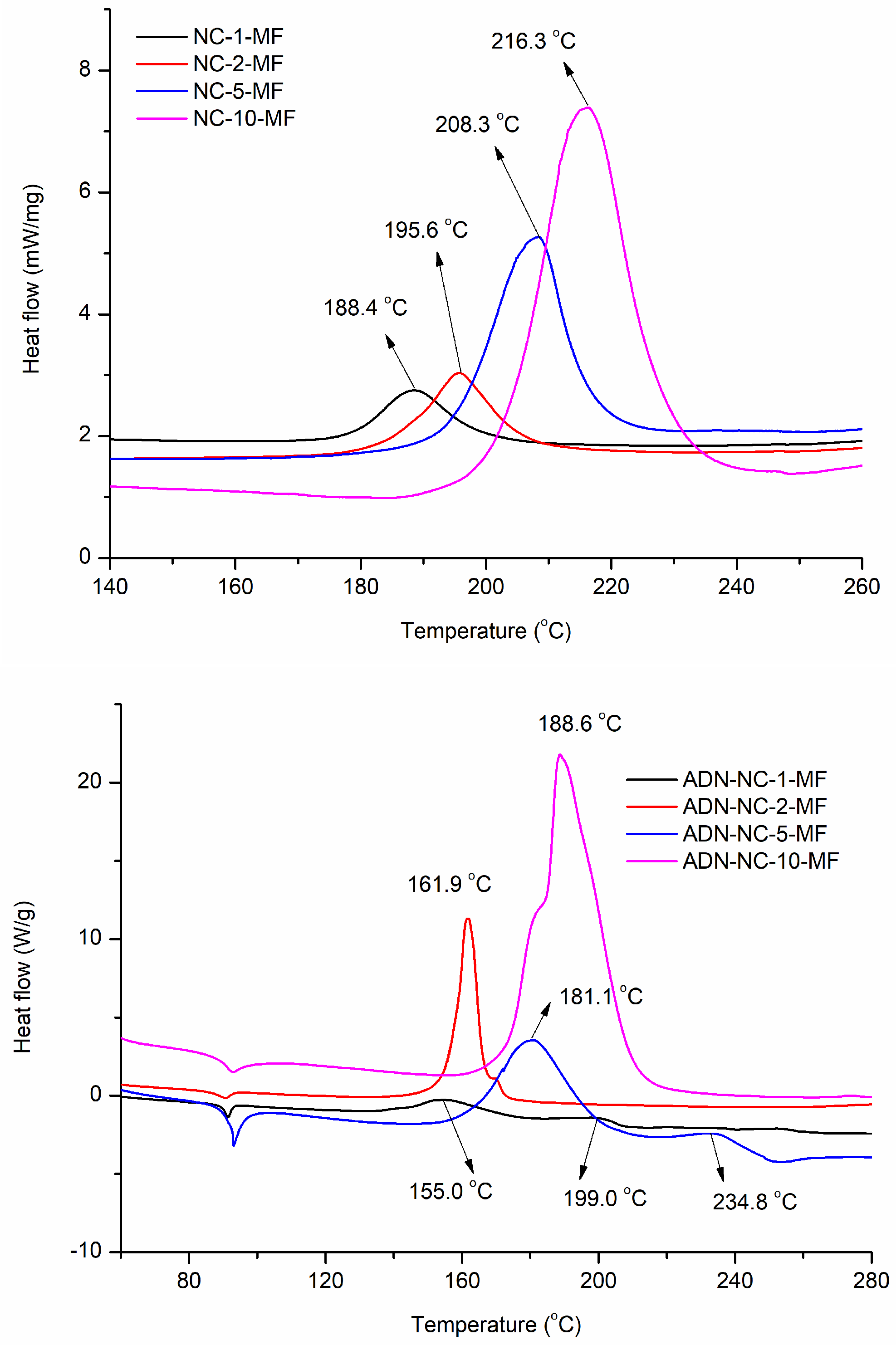
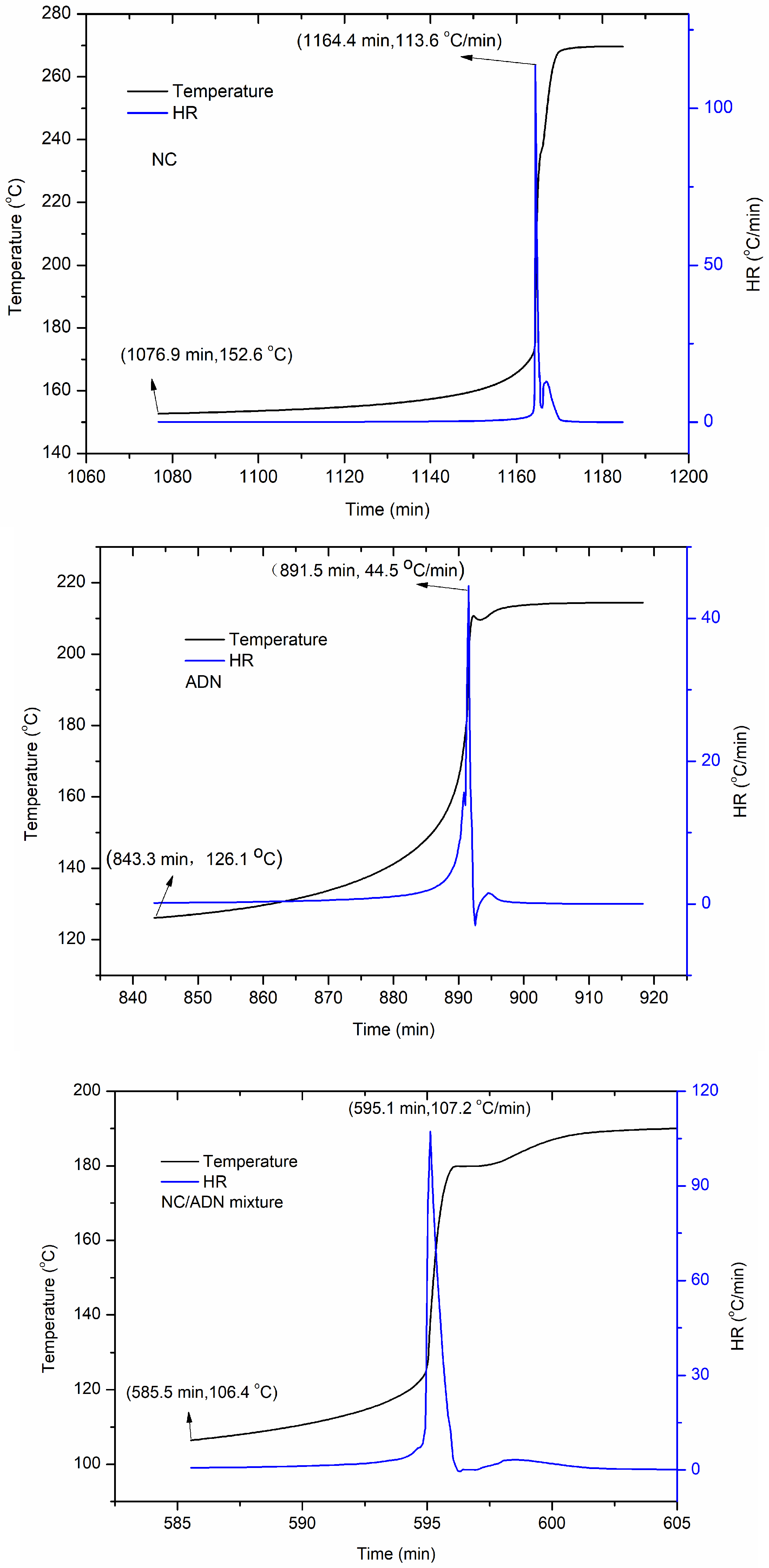


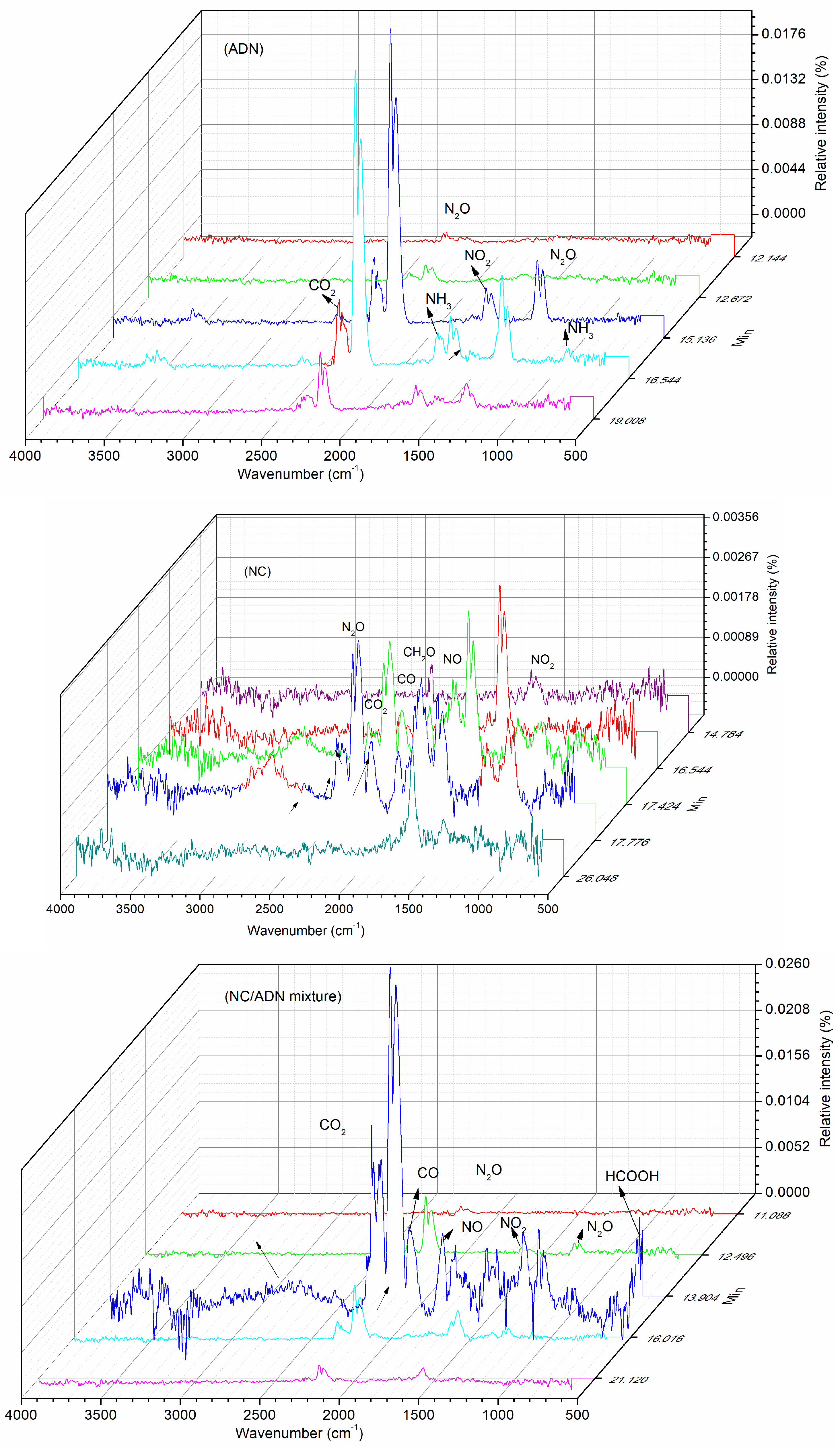
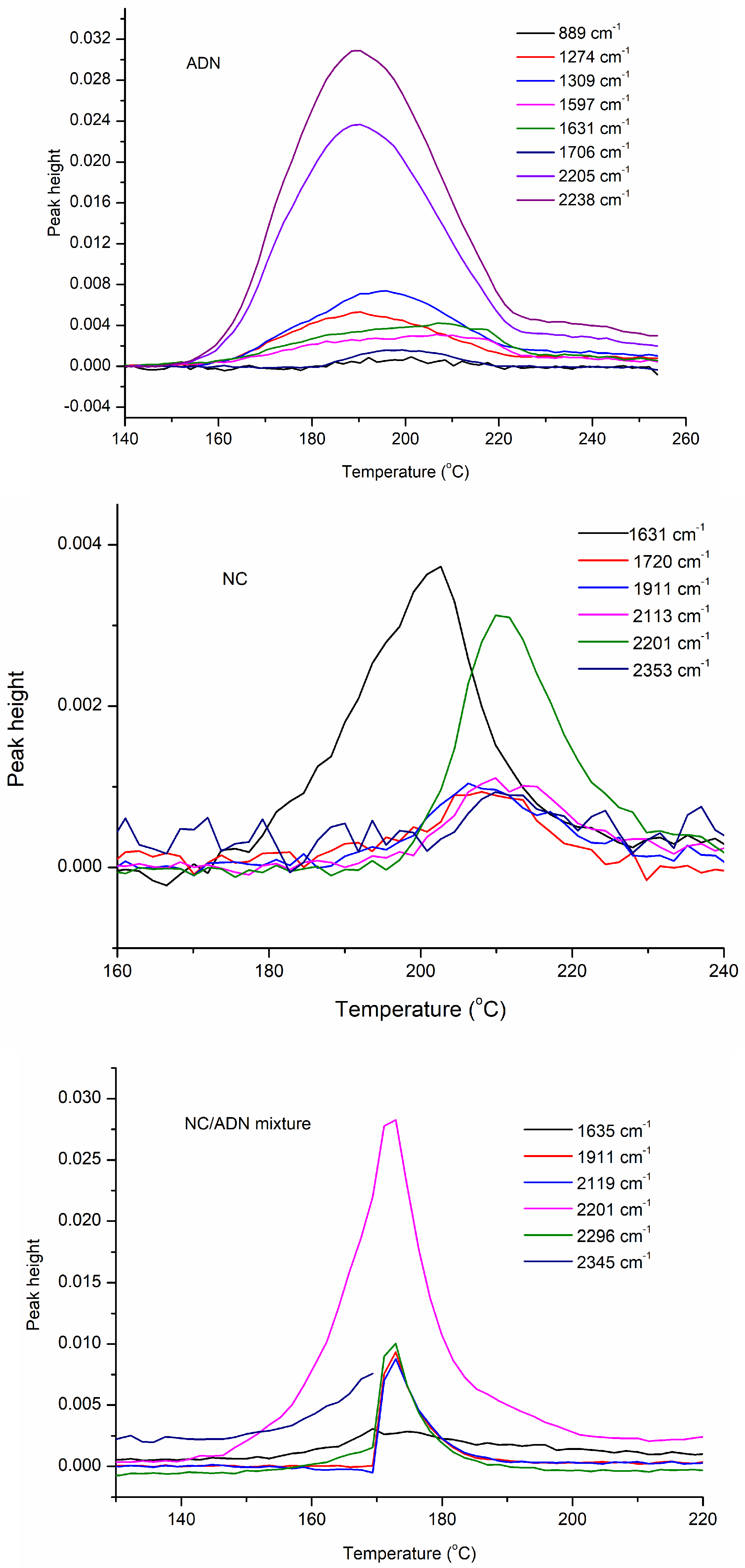
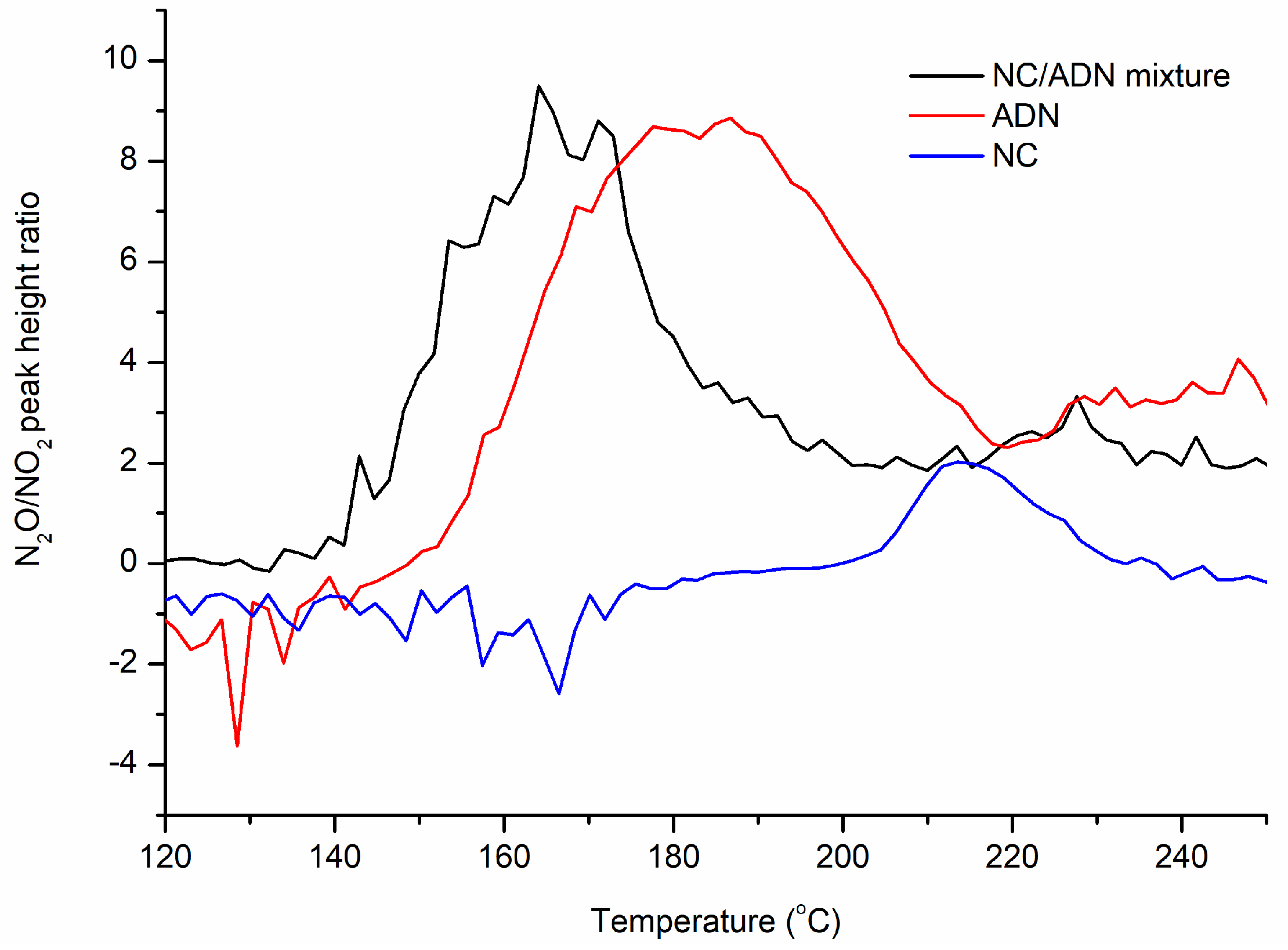
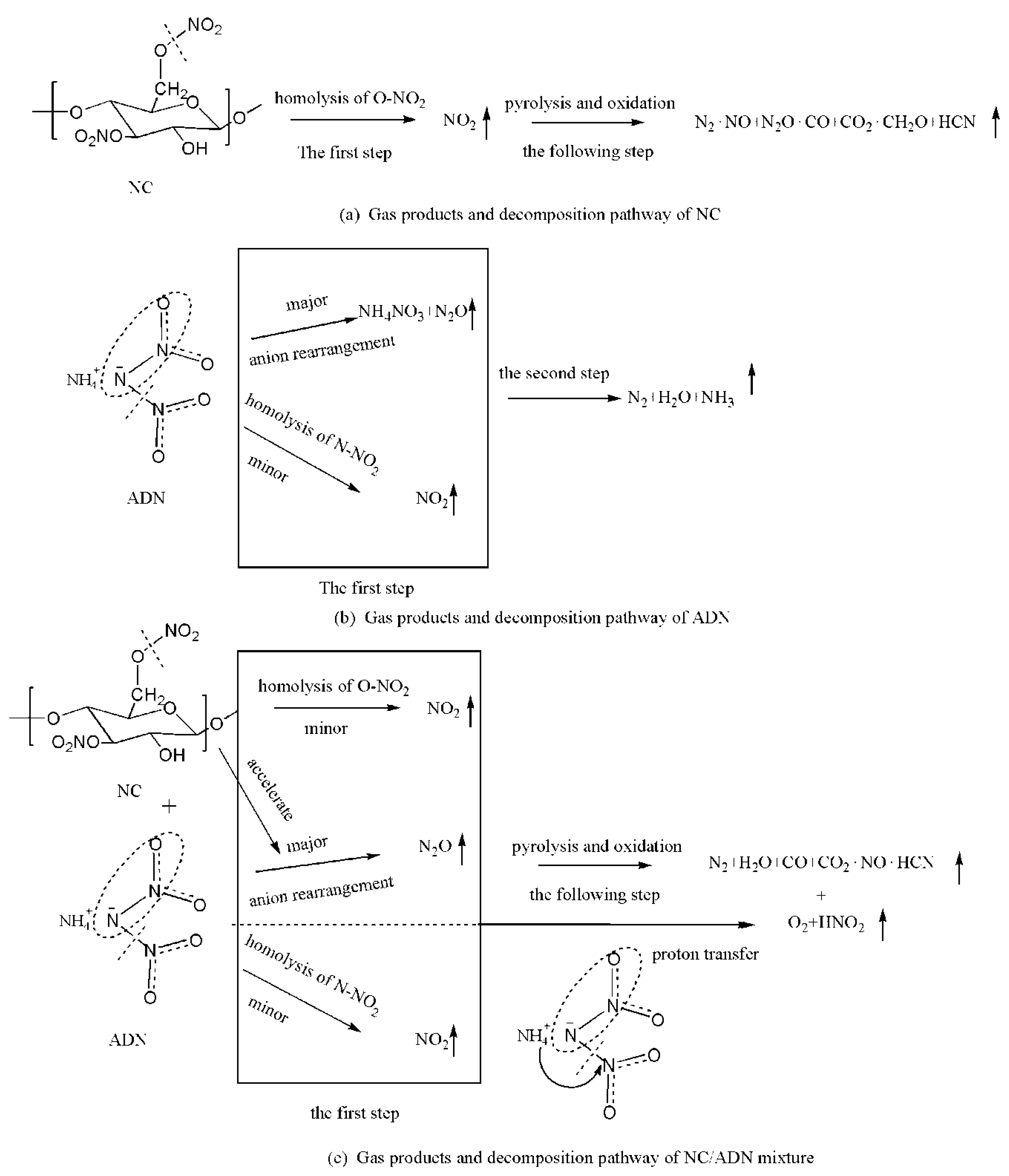
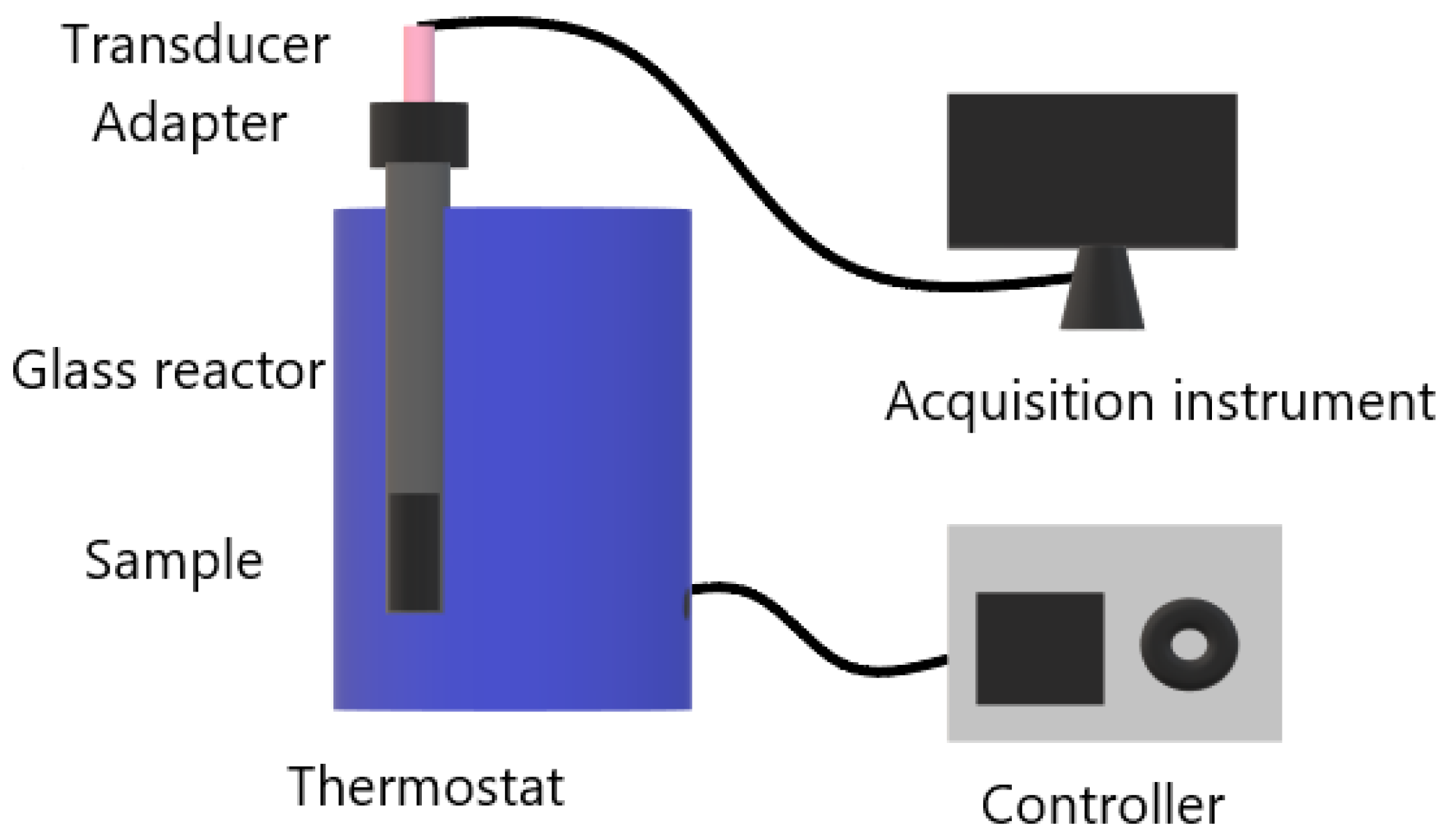
| Sample | Peak Temperature (°C) | Ea/(kJ·mol−1) | |||
|---|---|---|---|---|---|
| 1 °C/min | 2 °C/min | 5 °C/min | 10 °C/min | ||
| ADN | 155.3 | 168.8 | 180.8 | 199.3 (185.8) | 83.2 (R2 = 0.98) |
| NC | 188.4 | 195.6 | 208.3 | 216.3 (208.0) | 143.7 (R2 = 0.99) |
| NC/ADN mixture | 155.0 | 161.9 | 181.1 | 188.6 (172.0) | 96.8 (R2 = 0.98) |
| Sample | Temperature at the INITIAL Detection Point (°C) | Heating Rate at the Initial Detection Point (°C/min) | Heating Time at the Initial Detection Point (min) | The Maximum Temperature Rise Rate (°C/min) | Time to the Maximum Temperature Rise Rate (min) |
|---|---|---|---|---|---|
| ADN | 126.1 | 0.14 | 843.3 | 44.5 | 48.2 |
| NC | 152.6 | 0.03 | 1076.9 | 113.6 | 87.5 |
| NC/ADN mixture | 106.4 | 0.70 | 585.5 | 107.2 | 9.6 |
| Sample | Initial Condition (Vacuum) | Initial Condition (Air Atmosphere) | ||||
|---|---|---|---|---|---|---|
| Initial Pressure (kPa) | Pressure after 40 h (kPa) | Pressure Difference (kPa) | Initial Pressure (kPa) | Pressure after 40 h (kPa) | Pressure Difference (kPa) | |
| ADN | 1.01 | 1.96 | 0.95 | 116.71 | 119.62 | 2.91 |
| NC | 0.58 | 0.74 | 0.16 | 118.65 | 118.78 | 0.13 |
| NC/ADN mixture | 1.15 | 4.54 | 3.39 | 120.15 | 247.31 | 127.16 |
| Charge Mass Ratio | Assignment | Initial Temperature (°C) | Peak Temperature (°C) | Relatively Intensity × 1011 (%) |
|---|---|---|---|---|
| 14 | N | 152.0 | 191.4 | 2.48 |
| 15 | NH | 152.4 | 191.4 | 0.15 |
| 16 | O, NH2 | 157.4 | 192.4 | 2.40 |
| 17 | OH, NH3 | 153.4 | 202.4 | 4.00 |
| 18 | H2O | 157.9 | 202.9 | 21.4 |
| 28 | N2 | 147.9 | 192.4 | 21.1 |
| 30 | NO | 143.9 | 187.4 | 2.74 |
| 32 | O2 | None | None | None |
| 44 | N2O | 146.9 | 187.4 | 7.22 |
| 45 | HNNO | 155.4 | 188.4 | 0.11 |
| 46 | NO2 | 147.9 | 196.9 | 0.07 |
| 47 | HNO2 | None | None | None |
| 63 | HNO3 | None | None | None |
| Charge Mass Ratio | Assignment | Initial Temperature (°C) | Peak Temperature (°C) | Relatively Intensity × 1011 (%) |
|---|---|---|---|---|
| 16 | O | 185.2 | 210.6 | 3.12 |
| 17 | OH | 195.4 | 214.2 | 3.53 |
| 18 | H2O | 190.3 | 214.9 | 19.3 |
| 26 | CN | 190.4 | 209.1 | 0.16 |
| 27 | HCN | 194.9 | 212.4 | 0.65 |
| 28 | N2, CO | 185.9 | 210.8 | 26.5 |
| 29 | CHO | 188.9 | 211.4 | 0.66 |
| 30 | NO, CH2O | 170.5 | 208.9 | 4.87 |
| 32 | O2 | None | None | None |
| 43 | NCO | 191.9 | 211.4 | 0.13 |
| 44 | N2O, CO2 | 178.9 | 210.9 | 6.35 |
| 46 | NO2 | 170.5 | 205.9 | 0.09 |
| 47 | HNO2 | None | None | None |
| 63 | HNO3 | None | None | None |
| Charge Mass Ratio | Assignment | Initial Temperature (°C) | Peak Temperature (°C) | Relatively Intensity × 1011 (%) |
|---|---|---|---|---|
| 16 | O | 156.1 | 171.5 | 34.6 |
| 17 | OH | 155.3 | 171.8 | 34.5 |
| 18 | H2O | 158.8 | 175.8 | 61.0 |
| 26 | CN | 156.8 | 171.8 | 1.11 |
| 27 | HCN | 160.8 | 176.3 | 1.05 |
| 28 | N2, CO | 152.8 | 176.3 | 56.0 |
| 29 | CHO | 159.8 | 176.3 | 1.11 |
| 30 | NO | 145.3 | 176.3 | 19.3 |
| 32 | O2 | 162.8 | 175.7 | 7.69 |
| 43 | NCO | 146.3 | 175.8 | 0.23 |
| 44 | N2O, CO2 | 147.8 | 171.8 | 239 |
| 46 | NO2 | 144.8 | 171.8 | 1.77 |
| 47 | HNO2 | 164.3 | 171.8 | 0.07 |
| 63 | HNO3 | None | None | None |
| Wavelength (cm−1) | Assignment | Initial Temperature (°C) | Peak Temperature (°C) | ||||
|---|---|---|---|---|---|---|---|
| ADN | NC | NC/ADN Mixture | ADN | NC | NC/ADN Mixture | ||
| 889 | NH3 | 177.6 | —— | —— | 201.1 | —— | —— |
| 1274 | N2O | 144.8 | 199.0 | 139.3 | 190.5 | 211.7 | 172.9 |
| 1309 | N2O | 152.1 | —— | 146.4 | 195.5 | —— | 169.3 |
| 1597 | NO2 | 146.7 | 177.3 | 148.2 | 206.7 | 202.7 | 174.6 |
| 1631–1635 | NO2 | 141.2 | 166.5 | 153.5 | 206.7 | 202.7 | 169.4 |
| 1706 | NH3 | 181.2 | —— | —— | 199.4 | —— | —— |
| 1720 | CHO, HCOOH | —— | 184.6 | —— | —— | 208.1 | —— |
| 1745 | CHO, HCOOH | —— | 199.0 | —— | —— | 211.7 | —— |
| 1911 | NO | —— | 186.4 | 169.3 | —— | 206.3 | 172.9 |
| 2113–2119 | CO | —— | 189.9 | 169.3 | —— | 209.9 | 172.9 |
| 2201–2205 | N2O | 148.5 | 195.4 | 139.3 | 190.3 | 209.9 | 172.9 |
| 2238 | N2O | 146.7 | 197.2 | 141.1 | 190.3 | 211.7 | 169.3 |
| 2345–2353 | CO2 | —— | 200.8 | 144.6 | —— | 209.9 | 169.4 |
Disclaimer/Publisher’s Note: The statements, opinions and data contained in all publications are solely those of the individual author(s) and contributor(s) and not of MDPI and/or the editor(s). MDPI and/or the editor(s) disclaim responsibility for any injury to people or property resulting from any ideas, methods, instructions or products referred to in the content. |
© 2023 by the authors. Licensee MDPI, Basel, Switzerland. This article is an open access article distributed under the terms and conditions of the Creative Commons Attribution (CC BY) license (https://creativecommons.org/licenses/by/4.0/).
Share and Cite
Wang, Q.; Wang, X.-H.; Pan, Q.; Chang, H.; Yu, H.-J.; Pang, W.-Q. Thermal Behaviors and Interaction Mechanism of Ammonium Dinitramide with Nitrocellulose. Molecules 2023, 28, 2346. https://doi.org/10.3390/molecules28052346
Wang Q, Wang X-H, Pan Q, Chang H, Yu H-J, Pang W-Q. Thermal Behaviors and Interaction Mechanism of Ammonium Dinitramide with Nitrocellulose. Molecules. 2023; 28(5):2346. https://doi.org/10.3390/molecules28052346
Chicago/Turabian StyleWang, Qiong, Xiao-Hong Wang, Qing Pan, Hai Chang, Hong-Jian Yu, and Wei-Qiang Pang. 2023. "Thermal Behaviors and Interaction Mechanism of Ammonium Dinitramide with Nitrocellulose" Molecules 28, no. 5: 2346. https://doi.org/10.3390/molecules28052346
APA StyleWang, Q., Wang, X.-H., Pan, Q., Chang, H., Yu, H.-J., & Pang, W.-Q. (2023). Thermal Behaviors and Interaction Mechanism of Ammonium Dinitramide with Nitrocellulose. Molecules, 28(5), 2346. https://doi.org/10.3390/molecules28052346






